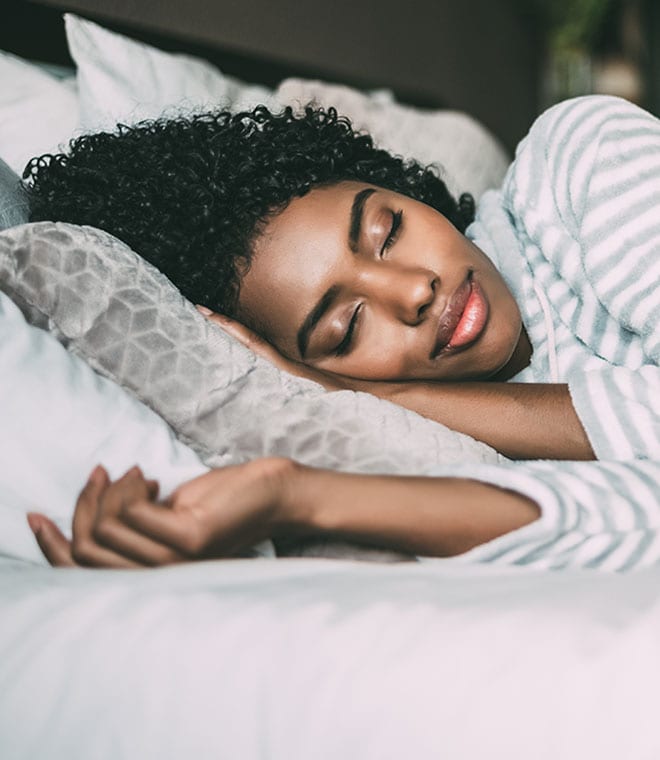Wellness
Sleep apnea: Causes, symptoms and treatment
By Jenilee Matz, MPH Jan 30, 2025 • 9 min
Snoring loudly and waking up gasping for air are signs of sleep apnea. While this sleep disorder is common, many people with sleep apnea aren't aware of their irregular breathing during sleep.
What is sleep apnea?
Sleep apnea is a common sleep disorder in which breathing stops and starts repeatedly during sleep. "Apnea" refers to a pause in breathing that lasts at least 10 seconds. A person with sleep apnea can experience pauses in breathing five to 30 times per hour or more during sleep. This irregular breathing pattern can cause disrupted sleep and low blood oxygen levels. If left untreated, it can lead to serious health conditions, such as high blood pressure, heart disease and type 2 diabetes. It can also leave you feeling drowsy during the day, which increases the risk of motor vehicle and workplace accidents.
Types of sleep apnea
The three main types of sleep apnea include:
- Obstructive sleep apnea: In this most common form of sleep apnea, your airway repeatedly becomes narrowed or blocked when the muscles in the back of the throat relax during sleep. This limits the amount of air that reaches your lungs and causes the level of oxygen in your blood to drop. Signals are sent to the brain to wake you up briefly so you can take a breath. Normal breathing often resumes with a snort or choking sound.
- Central sleep apnea: This type of sleep apnea occurs when the brain doesn't correctly control breathing during sleep. This causes you to not breathe for a short period of time. Often people with central sleep apnea have another medical condition, such as heart failure.
- Complex sleep apnea: This is also known as "mixed sleep apnea," and is when someone has both obstructive and central sleep apnea.
Sleep apnea causes
Risk factors for obstructive sleep apnea include:
- Excess body weight
- Having a large neck or a narrowed airway
- Using alcohol, sedatives or tranquilizers
- Smoking
- Nasal congestion
- Having a family history of sleep apnea
Central sleep apnea risk factors include:
- Having heart disorders, such as congestive heart failure
- Using narcotic pain medications, including opioids
- Having a history of stroke
Males and older adults have a higher chance for both types of sleep apnea. However, anyone can develop sleep apnea, including children. Sleep apnea in children may be caused by large tonsils or adenoids that narrow or block the airway.
Is sleep apnea genetic?
Yes, sleep apnea can be genetic. Obstructive sleep apnea appears to run in some families.
Sleep apnea symptoms
Signs of obstructive and central sleep apnea tend to overlap. Both conditions can cause:
- Chronic loud snoring
- Gasping, snorting or choking for air during sleep
- Episodes when you stop breathing during sleep. This causes you to wake up, but it's so brief, you may not remember it. Someone who shares a room with you may alert you to this symptom.
- Waking up with a dry mouth
- Headaches in the morning
- Trouble staying asleep at night
- Excessive sleepiness during the day
- Trouble with concentration, memory or learning
- Irritability
- Depression
- Sexual dysfunction
When to see your healthcare provider
If you have symptoms of sleep apnea, see your healthcare provider. If you're unsure of your symptoms, consider taking one of the American Sleep Apnea Association's tests, such as the Snore Score, Epworth Sleepiness Scale, Berlin sleep questionnaire or STOP-BANG. The results from these tests can help you decide if you should talk to your healthcare provider about sleep apnea.
Diagnosing sleep apnea
Only your healthcare provider can make a sleep apnea diagnosis. Your provider will likely review your medical history, ask you about your symptoms and give you an exam. Based on these results, your provider may refer you to a sleep specialist.
Next, you may have a sleep apnea test or sleep study done. Sleep studies often happen in a sleep center and involve overnight monitoring of your bodily functions, such as sleep state, heart rate, airflow and blood oxygen levels while you're asleep. In some cases, home sleep monitoring may be an option. Your healthcare provider may use the apnea-hypopnea index (AHI) to measure the severity of your sleep apnea. This index tracks the average number of apneas and hypopneas that occur each hour.
What is hypopnea?
It's abnormally slow and shallow breathing. The AHI can be used to tell if you have sleep apnea, and if it's mild, moderate or severe. A higher AHI number indicates a more severe case of sleep apnea.
How to treat sleep apnea
It's important to understand that sleep apnea is a serious condition that requires treatment. The diagnosis of obstructive sleep apnea treatment is dependent on the severity and cause of your apnea. For mild sleep apnea, your healthcare provider may suggest lifestyle changes, like losing weight, avoiding alcohol and quitting smoking. If you have obstructive sleep apnea when sleeping on your back, using a pillow to force yourself on your side may help improve your sleep quality. If these measures don't improve your sleep, or if you have more severe sleep apnea, your provider may recommend devices or procedures, such as:
- Continuous positive airway pressure (CPAP). This sleep apnea machine or sleep apnea mask is often the treatment of choice for obstructive sleep apnea. The mask fits over your nose or nose and mouth and lightly blows air into your airway to help keep it open while you sleep. CPAPs are highly effective when used regularly. Your provider may also suggest other airway pressure devices if they're better suited for you.
- Oral appliances or mouthpieces are typically custom-fit devices that help keep your airway open during sleep. Your provider may prescribe these devices if you have mild to moderate obstructive sleep apnea or if it mostly occurs when you sleep on your back.
- Upper airway stimulation. This small device, approved by the U.S. Food and Drug Administration (FDA) in 2014 for moderate to severe obstructive sleep apnea, is surgically implanted in the chest. While you sleep, the device monitors your breathing and stimulates a nerve in the tongue that keeps the upper airway open.
- Surgery. In some cases, your healthcare provider may suggest surgery to treat your obstructive sleep apnea symptoms. This option is usually reserved as a last resort if nonsurgical treatments didn't help. It may involve one or more surgeries to reshape structures in the upper airways or surgically reposition bone or soft tissue to keep the airway open.
If you have symptoms of sleep apnea, you should see your healthcare provider. Seeking treatment can help ease your symptoms of fatigue and reduce your risk of complications. Discussing treatment options with your provider can help you manage your sleep apnea.
Updated January 2025.
Sources:
- https://www.sleepfoundation.org/sleep-apnea
- https://www.nhlbi.nih.gov/health-topics/sleep-apnea
- https://www.mayoclinic.org/diseases-conditions/sleep-apnea/symptoms-causes/syc-20377631
- https://medlineplus.gov/lab-tests/sleep-study/
- https://www.uptodate.com/contents/clinical-presentation-and-diagnosis-of-obstructive-sleep-apnea-in-adults
- https://www.sleepfoundation.org/sleep-apnea/ahi
- https://www.sleepassociation.org/sleep-apnea/surgery/
- https://www.thoracic.org/patients/patient-resources/resources/obstructive-sleep-apnea-in-adults.pdf.
- https://www.ninds.nih.gov/health-information/disorders/sleep-apnea
- https://www.ada.org/resources/research/science-and-research-institute/oral-health-topics/sleep-apnea-obstructive




